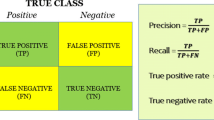Summary
Preliminary results of a machine learning application concerning computer-aided molecular design applied to drug discovery are presented. The artificial intelligence techniques of machine learning use a sample of active and inactive compounds, which is viewed as a set of positive and negative examples, to allow the induction of a molecular model characterizing the interaction between the compounds and a target molecule. The algorithm is based on a twofold phase. In the first one — the specialization step — the program identifies a number of active/inactive pairs of compounds which appear to be the most useful in order to make the learning process as effective as possible and generates a dictionary of molecular fragments, deemed to be responsible for the activity of the compounds. In the second phase — the generalization step — the fragments thus generated are combined and generalized in order to select the most plausible hypothesis with respect to the sample of compounds. A knowledge base concerning physical and chemical properties is utilized during the inductive process.
Similar content being viewed by others
References
See, for example: Martin, Y.C., Quantitative Drug Design, Marcel Dekker, New York, 1978, pp. 167–213.
Kowalski, B.R. and Bender, C.F., J. Am. Chem. Soc., 96 (1974) 916.
Chu, K.C., Feldmann, R.J., Shapiro, N.B., Harard, G.F. and Geran, R.I., J. Med. Chem., 18 (1975) 539.
Klopman, G., J. Am. Chem. Soc., 106 (1984) 7315.
Aoyama, T., Suzuki, Y. and Ichikawa, H., J. Med. Chem., 33 (1990) 905.
Biosym Technologies Inc., 10065 Barnes Canyon Road, San Diego, CA 92121.
Govers, H. and deVoogt, P., Quant. Struct.-Act. Relat., 8 (1989) 11.
Carbonell, J.G., Machine Learning, In Shapiro, S.C. (Ed.) Encyclopedia of Artificial Intelligence, Vol. 1, John Wiley, New York, NY, 1987, pp. 464–488.
Michalski, R.S., A theory and methodology of inductive learning, In Michalski, R.S., Carbonell, J.G. and Mitchell, T.M. (Eds.) Machine Learning Vol. 1. Tioga, Palo Alto, (1983), pp. 83–134.
Mitchell, T.M., Towards combining empirical and analytical methods for learning heuristics, In Elithorn, A. and Banerji, R. (Eds.) Human and Artificial Intelligence, North-Holland, Amsterdam, 1984, pp. 67–103.
Bertz, S.H. and Herndon, W.C., In Pierce, T.H. and Hohne, B.A. (Eds.) Artificial Intelligence Applications in Chemistry (ACS Symposium Series, No. 306), 1986, pp. 169–175.
Flann, N. and Dietterich, T., Selecting appropriate representations for learning from examples, In Proceedings of the American Conference on Artificial Intelligence, AAAI, 1986, pp. 460–466.
For further details see: Bolis, G., DiPace, L. and Fabrocini, F., Shift of bias in learning from drug compounds, In Proceedings of the European Working Session on Machine Learning, EWSL-91, Springer-Verlag, Berlin, 1991, pp. 182–194.
The Brookhaven PDB codes for some of such structures are, for example: 4TLN, 5TLN, 7TLN, 1TLP, 6TMN.
Bernstein, F.C., Koetzle, T.F., Williams, G.J., MeyerJr., E.E., Brice, M.D., Rodgers, J.R., Kennard, O., Shimanouchi, T. and Tasumi, M., J. Mol. Biol., 112 (1977) 535.
Abola, E.E., Bernstein, F.C., Bryant, S.H., Koetzle, T.F. and Weng, J., Protein data bank In Allen, F.H., Bergerhoff, G. and Sievers, R. (Eds.) Crystallographic Databases — Information Content, Software Systems, Scientific Applications, Data Commission of the International Union of Crystallography, Bonn/Cambridge/Chester, 1987, pp. 107–132.
Nishino, N. and Powers, J.C., Biochemistry, 17 (1978) 2846.
Nishino, N. and Powers, J.C., Biochemistry, 18 (1979) 4340.
Kam, C.-M., Nishino, N. and Powers, J.S., Biochemistry, 18 (1979) 3032.
Feder, J., Brougham, L.R. and Wildi, B.S., Biochemistry, 13 (1974) 1186.
Holmes, M.A. and Matthews, B.W., Biochemistry, 20 (1981) 6912.
Author information
Authors and Affiliations
Rights and permissions
About this article
Cite this article
Bolis, G., Di Pace, L. & Fabrocini, F. A machine learning approach to computer-aided molecular design. J Computer-Aided Mol Des 5, 617–628 (1991). https://doi.org/10.1007/BF00135318
Received:
Accepted:
Issue Date:
DOI: https://doi.org/10.1007/BF00135318




